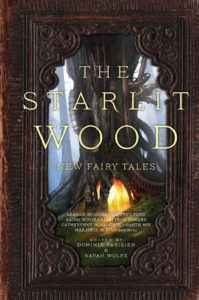 In this week’s Starlit Wood blog post, the wonderful Aliette de Bodard talks about “Pearl”.
In this week’s Starlit Wood blog post, the wonderful Aliette de Bodard talks about “Pearl”.
1. What was the inspiration for your story in The Starlit Wood?
The story of Dã Tràng and the pearl has always stuck with me: it’s a classic Vietnamese tale of how helpfulness turns to hubris and addiction—I remember being horrified by the idea of crabs endlessly trying to bring sand into the sea. I wanted to tell it as a space opera, because to me space opera has a lot of the same mythical, larger-than-life components than fairytales (something which I’ve amply used in my own work!)
2. What appealed to you about a fairy tale anthology?
I love fairytales, and the way that their motifs echo down time for us—but I’ve started reading them to my son, and have been struck anew by how many assumptions they make about daily life and characters: in many ways they are very much of their time (the idea of the prince, for example, though it has staying power, doesn’t make sense to people living in a democracy, or certainly not the same kind of sense it would have made back them). For me the main attraction of this anthology was being able to look at those motifs through a more contemporary or at any rate a different lens: to retell and to transform and give new meanings to old images.
3. Can you recall the first fairy tale you ever read or that was read to you?
I don’t! Both my mother and my maternal grandmother read a lot of them to me when I was a child, and it would be hard for me to remember the first one. The one I remember being struck by is Truong Chi và Mi Nuong, which is a tragic love story between a fisherman and the daughter of a high-rank official: she spurns him, and the fisherman wastes away. He leaves behind a wooden block (or in some variants, jade), which is carved into a bowl and brought to the daughter. When she uses the bowl, the fisherman’s voice rises from its depths, and this song moves her so much that she cries. Her tears break the bowl, allowing the fisherman’s soul to depart.
4. What’s your favourite folk/fairy tale and why?
Ha, that’s a little like picking favourite children, isn’t it? My current favourite is Tam Cám, one of the most famous ones from Vietnam, which is about the rivalry between two sisters and how this impacts the marriage of one of them to the king. There’s a magical fish, a loom that speaks with the voice of a carved raven, a golden fruit, and pâté made from the flesh of the dead, because what’s a good fairytale without some major creepiness?
5. What’s next for you?
I’m working on book 3 of Dominion of the Fallen, my Gothic noir fantasy set in an alternate Paris which includes Fallen angels, Vietnamese dragons in human form, magicians and alchemists (I recently published a novelette set in this universe, “Children of Thorns, Children of Water”, here at Uncanny). And I have a couple stories in upcoming anthologies, notably Alma Alexander’s Children of a Different Sky. 
Aliette de Bodard writes speculative fiction: her short stories have garnered her two Nebula Awards, a Locus Award and two British Science Fiction Association Awards. She is the author of the Dominion of the Fallen series, set in a turn-of-the-century Paris devastated by a magical war, which comprises The House of Shattered Wings (2015 British Science Fiction Association Award, Locus Award finalist), and its standalone sequel The House of Binding Thorns (Ace, Gollancz). She lives in Paris. Visit http://www.aliettedebodard.com for more information.

